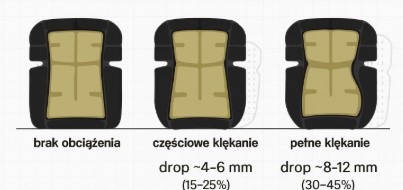- today
- perm_identity Igor z Balticbhp
- label News
- favorite 0 likes
What will you find today in the Workwear Academy?
-
we show the difference between kneepads for occasional kneeling and those for long-term kneeling
-
inserts for trousers or external kneepads – what are the pros and cons?
1️⃣ Do you kneel frequently? You need different protection

Look at the graphic below. Do you see the difference in material flex and cushioning while kneeling? Under full load, the kneepad compresses about 45% of its original thickness. For foam kneepads, it was up to 60%. Here shown with Snickers 9119 kneepads. It’s a bit like off-road versus sports car suspension.
I hope this clarifies things and now you “get kneepads”. Choosing consciously will help you avoid disappointment if you buy models that are too hard or too soft.

2️⃣ External kneepads or trouser inserts? Pros and cons
Ok, let’s go through the pros and cons of both solutions. As always, it’s hard to say which is best – most often the answer is: it depends.
Kneepads inserted into trousers – remember they are usually used for less “floor-heavy” work. They offer better comfort while walking but less protection while kneeling.
Pros of insert kneepads:
-
✅ Comfort – no straps behind the knee, no chafing.
-
✅ Lightweight and flexible – perfect for jobs where you move a lot and often get up.
-
✅ Stay in place – if trousers are well-fitted, the kneepad stays put.
-
✅ Nothing sticks out – nothing snags on elements.
-
✅ Better ventilation – external kneepads often constantly press against the knee and can cause sweating. Inserts allow airflow while walking and wick away moisture.
Cons of insert kneepads:
-
❌ Less side protection – they mainly protect from below, cushioning the impact with the floor.
-
❌ Require trousers with kneepad pockets – not compatible with every model. If you often wear them outside kneeling work, Cordura on the knees may cause sweating and reduce ventilation.
-
❌ Harder to adjust height – pockets are fixed in place. While you can pull up the trousers, it’s inconvenient.
-
❌ Limited compatibility – different trousers use different pocket stitching, affecting how kneepads fit.
External kneepads
Let’s be clear – they’re not meant for walking around in. They provide better joint protection but also have limitations, like poor ventilation and the hassle of putting them on/off – which is why you usually keep them on all day.
Pros of external kneepads:
-
✅ Best cushioning – especially gel or hybrid models, heavier but more comfortable.
-
✅ Versatility – can be used with any trousers. You’re not limited by pocket systems or kneepad size.
-
✅ Better side and front protection – often larger contact surface and side coverage.
-
✅ Adjustable position – you can move them up or down depending on the task.
-
✅ Protection against uneven ground – hard shells protect against gravel, screws, etc.
-
✅ You don’t wear out your trousers – the external shell wears instead of your pants.
-
✅ You can unstrap them if not needed – though this is usually time-consuming.
Cons of external kneepads:
-
❌ Heavier and bulkier – can be uncomfortable if you stand up often.
-
❌ Risk of chafing from straps, especially in hot weather.
-
❌ May slip during intense movement.
-
❌ Poorer ventilation – can overheat the knee during long work, as they stay pressed against the leg.
⚡️ Pro tip from Balticbhp: sometimes it’s worth spending a bit more and buying two sets of kneepads for different types of work. Especially if you’re versatile and do everything from drywall installation to tiling.
I hope the kneepad topic is now a bit clearer. As always, if you have any questions, feel free to write to igor@balticenterprise.pl or on Messenger :).
Best regards!
